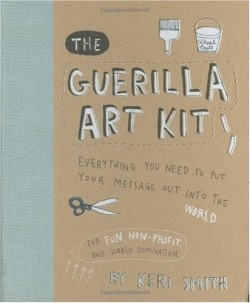The Guerilla Art Kit
Everything You Need to Put Your Message Out Into the World
Guerilla art is any anonymous work done in public spaces “with the distinct purpose of affecting the world in a creative or thought-provoking way.” Smith has tread this territory before with her books Wreck This Journal and Living Out Loud: Activities to Fuel a Creative Life.
The most appealing feature of this new work is its whimsical appearance. The small 6 x 7 ½ manual looks as if the author has just finished assembling it with a particular reader in mind. The cover appears to be fashioned from cardboard and electrical tape, while the front and back include Smith’s handwriting and simplistic drawings. Inside, thick cardstock pages are bound with a spiral and chock full of type styles and illustrations.
The author offers a wide range of activities in her thirty-two creative exercises. In “Knitted Tags” for example, she describes how to select an item to mark, such as a street sign, and then add a knitted or crocheted swatch onto it. Alternatives include knitting garlands for fences or ornaments for trees. In another exercise, “Moss Graffiti,” she shows how to blend moss and buttermilk to a creamy consistency and then paint it onto a wall, sometimes using a stencil. Over time, if kept damp, the moss begins to root, highlighting the design and eventually covering the whole area.
The tools and techniques section provides step-by-step directions on how to make a freezer paper stencil, how to make stickers, and even how to make a seed bomb—a self-germinating ball of mixed seed, compost, clay, and water. Further rounding out the resources are a glossary (defining terms such as meme hack, psychogeography, and subvertising); a bibliography (listing such books as The Interventionists: Users’ Manual for the Creative Disruption of Everyday Life); and recommended Web sites (including sites devoted to guerilla gardening, guerilla actions, and how to’s).
The author does admit that some of her proposed exercises might be labeled vandalism, but she skirts the issue by recommending that participants avoid security cameras and police. She also glosses over conventional street graffiti, noting that while some cities have embraced the concept, she avoids spray paint due to its toxicity. The author’s messages sometimes lack sophistication—such as secretly attaching paper cut-out footprints in office hallways or placing eye circles on parking meters—but that really doesn’t matter. The thrill of anonymity and adding to the environment creatively is quite appealing.
Reviewed by
Beth Hemke Shapiro
Disclosure: This article is not an endorsement, but a review. The publisher of this book provided free copies of the book to have their book reviewed by a professional reviewer. No fee was paid by the publisher for this review. Foreword Reviews only recommends books that we love. Foreword Magazine, Inc. is disclosing this in accordance with the Federal Trade Commission’s 16 CFR, Part 255.

